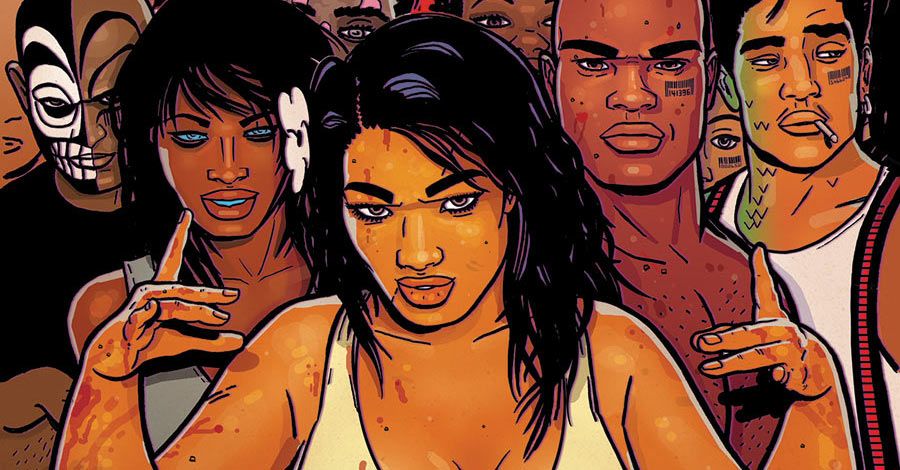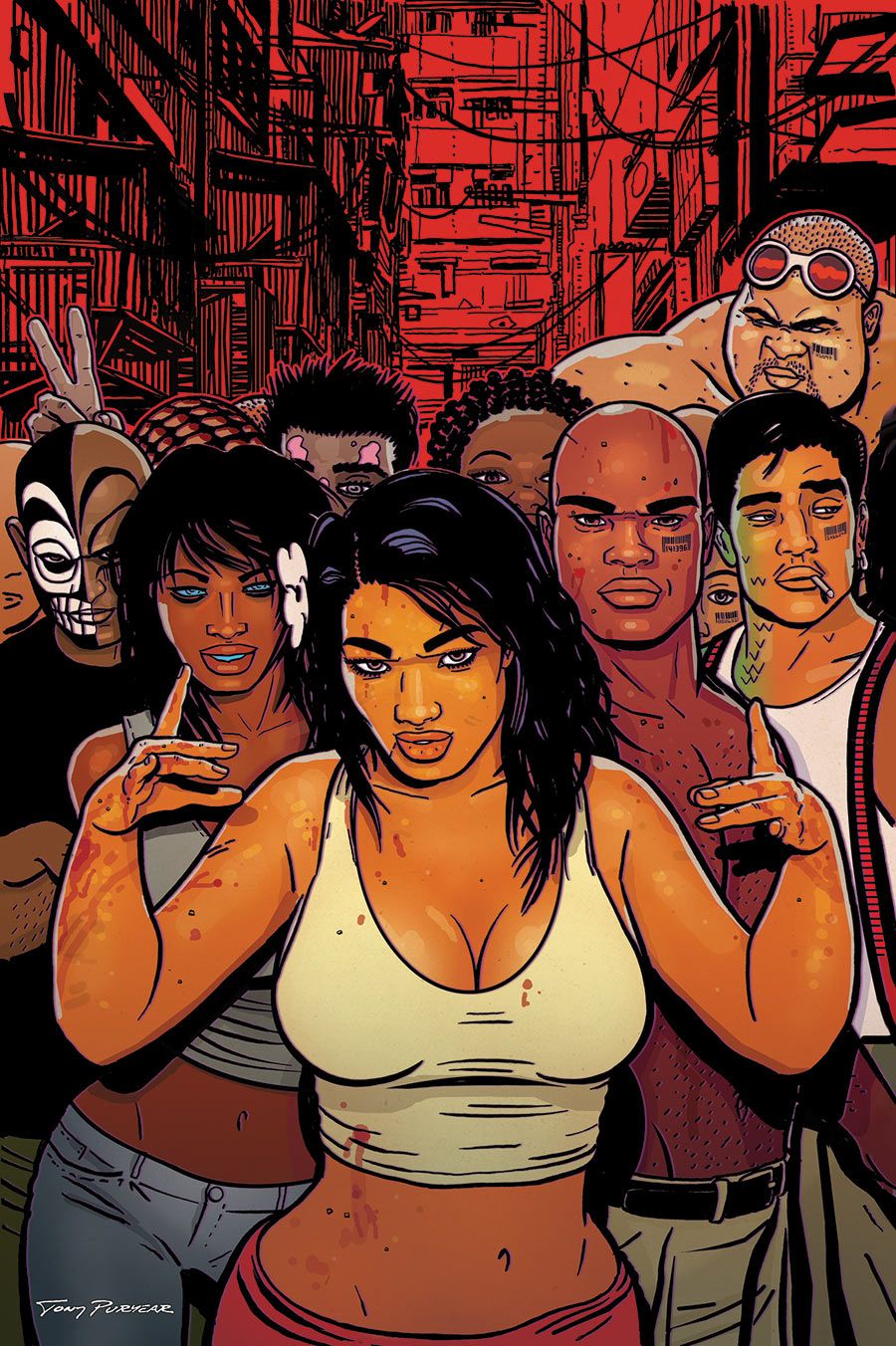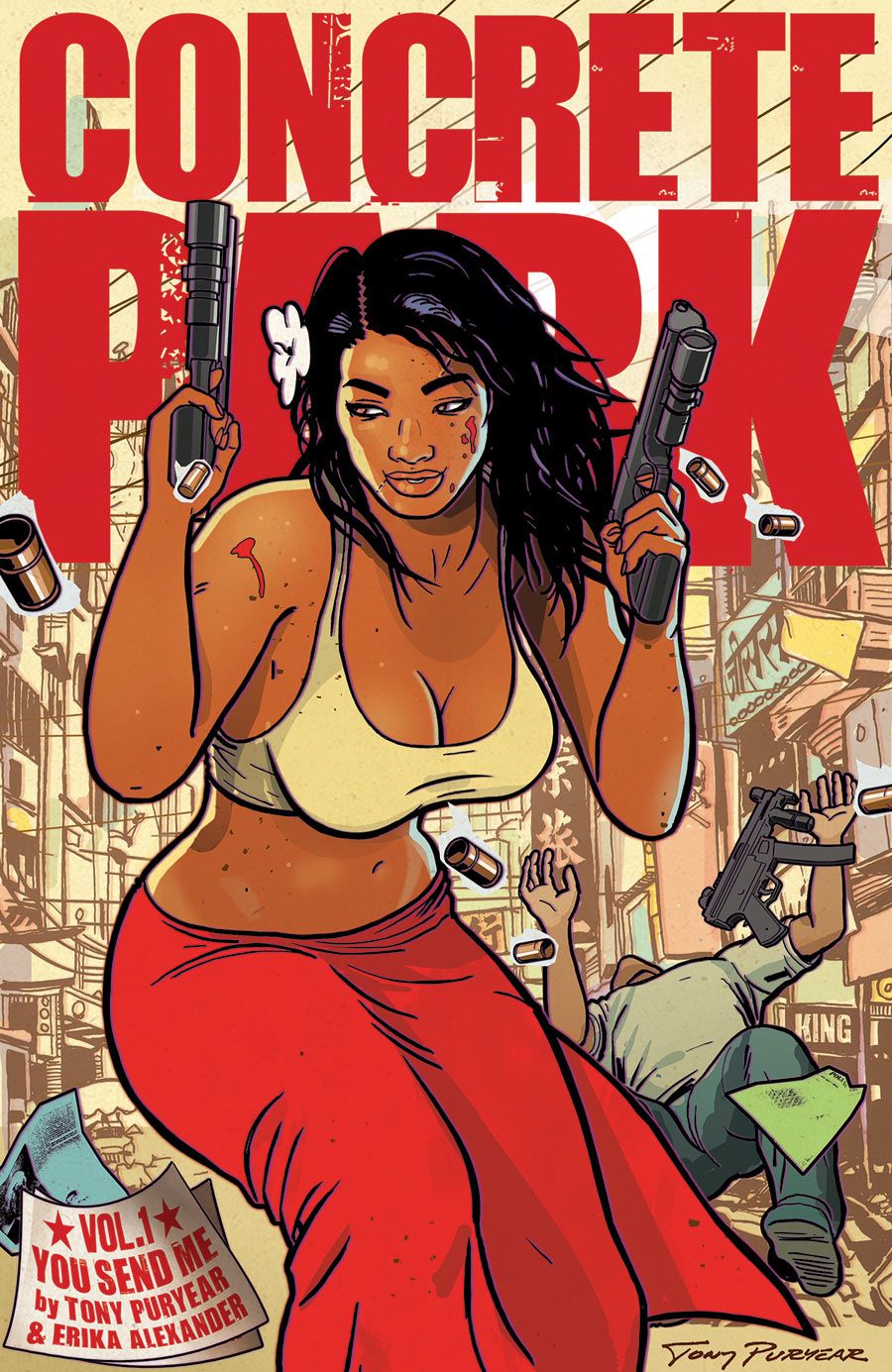The world of "Concrete Park" is a far-future dystopia that, despite its sci-fi foundation, looks an awful like the world of today. The prison planet of Oasis resembles, more than anything else, a bad part of East LA, or one of the less well-governed parts of Mexico. Gangs, factions and political figures vie for power in on an alien world that's as diverse and troubled as many parts of Earth. It's science fiction, certainly, but it also feels familiar.
The Dark Horse Comics series is the co-creation of the team of Tony Puryear and Erika Alexander; the two are co-writers, and Puryear handles the pencils and coloring. The team spoke with Comic Book Resources about their comic, which has already appeared in "Dark Horse Presents" -- a hardcover collection is scheduled for mid-October -- and is slated to debut an all-new five-issue miniseries subtitled "R-E-S-P-E-C-T" in September.
CBR News: While it's debuted in the "Dark Horse Presents" anthology, "Concrete Park" is still a new series. How would you sum it up?
Tony Puryear: We set out to make a sci-fi epic in a future that's as diverse as the world we know. What that means is different colors, different ethnicities, different languages, different cultures, different sexual orientations. We thought we could bring that to the future and show a really funky version of the future. But mainly, we want it to be entertaining and work on a big canvas. We admire "Game of Thrones," where you have an extended world [filled] with allegiances and loyalties and politics.
How did you get into the comic book game? This is your first book, right?
Erika Alexander: We got into the comic book game [while] trying to be film makers. The whole environment changed after 2000. There were new stars being made by reality shows. It was hard for our previous work to matter in this new world. [But], there were new voices coming from new places who needed new content, and one of those worlds was comic books. We had been trying to create a show or some kind of new entertainment world. People weren't buying. It seemed too big for them, or too risky. We were frustrated. We had a really disappointing meeting with a studio president where he decided to withdraw from what we were trying to make into a film or television show. That's how "Concrete Park" came around. The platform of comic books has a lower barrier to entry.
Where do you see the series going? Is this going to be a self-contained story, or an ongoing series?
Puryear: We hope it's a story platform that goes on for years. The five-issue miniseries that starts on September 3 tells one unit of the story. We've already told one unit of the story in the seven issues of "Dark Horse Presents" that we appeared in. Those will be collected in the first hardcover coming out in October. The second hardcover will have the five-issue miniseries. We hope that each unit moves the story forward and keeps the reader asking questions about what's going to happen next. It's meant to be ongoing.
You said you wanted to create a diverse environment. How well -- or badly -- do you think mainstream science fiction has handled the issue of diversity.
Puryear: On one hand, you'll see actors like Will Smith, arguably the biggest sci-fi star of his generation in the way that Charlton Heston used to be. There's no analogue to how many sci-fi movies Will Smith has done, from "I, Robot" to "After Earth" to whatever. But, that said, there's still so much more that mainstream science fiction isn't doing. Where are the women? Where's the cultural diversity? What will the world of the future be? I don't know if it will just be a world of macho guys saving the world all the time. It's nice to have a black man in that role, but that by itself isn't diversity. Our world speaks a lot of different languages -- there are are [different] spiritualities and gender and sexualities, and you don't see that in mainstream sci-fi.
Something that you find a lot in comic books and science fiction is the use of metaphor. For example, in "X-Men," mutants are a proxy for minorities, or aliens in "Star Trek." However, even when minority issues are being dealt with metaphorically, there haven't been many actual minorities on the page or on the screen. Here, you're making a science fiction comic book with actual minority characters. What's your read on comics and sci-fi using metaphor as a means to discuss minority issues?
Puryear: I had the privilege of working with Majel Rodenberry, Gene Rodenberry's widow. We developed a television project together -- it never went anywhere -- and she kept emphasizing to me that because of his experience in the Navy and in the LAPD, he saw a hopeful future full of people of different colors all mingling together. That was a key ingredient of "Star Trek" -- the hope that in the future, we'd have worked a lot of this stuff out.
But yes, you're right. Difference has been handled metaphorically, and you bring up a good example with the X-Men. You can go to a comic book convention and see differently-abled people, people of color, people of different gender orientations who of course identify with some of those outsider mutants. If you follow the "Concrete Park" story, we're going to be trying to address difference not just because we have different looking people on the page, but also we're going to try to address the differences inside of us. What is family? What is love? What is our spiritual future?
Alexander: [Metaphors] were very important then, in the '60s, when people were very worried about race. You could talk about an alien, and we'd know you were talking about race. People who were racist or who had those feelings could see those issues discussed without feeling they were targeted. I think that was important, for artists to create those stories that invited everyone in. But after a while, it has to be put right dead-center as opposed to talking around it. I believe art is responsible for changing the world -- and I do love metaphors for that reason, but I like it when people just put it square in front of you. This is what it is.
Getting back to the specifics of "Concrete Park," I noticed that the character of Isaac, who is black, is at one point on a very crowded ship and covered in chains. It's very evocative of the transatlantic slave trade. Was that intentional?
Puryear: [Laughs] Yes. This planet they're on is ironically named Oasis, when in fact it's a barren desert on most of its surface, but it does have resources. It has basic things like salt and, most importantly, water (in the form of ice) under its surface. The metaphor here is an Australia in space. They've been sent there as slaves. It's a penal colony, and once they're there, on planet, they're never getting off. They don't always have to go around in chains, but they're still slaves. Those people who survive at least a year in the mines all have bar codes on them. They're a product. They're scannable. They've all been hardened by slave labor in the mines, so it is an explicit connection, yeah.
Regarding the setting, what's happened with humanity's future here? What direction, as a species, have we gone down?
Alexander: Not so good. But, you know what? Maybe it's how everyone's feeling now. We're in a first-world country. The so-called Third World is what a majority of the Earth is experiencing. We get to live this life we have right now because of slaves in factories. We think we're living great lives with Starbucks and all these things -- but the suffering behind it is really dark, and it's not discussed a lot. When it is discussed, it's discussed as if it's somebody else's problem. I think that's what we're talking about now. To live this version of life, there are some people who have to pay the price.
So the point of view characters in "Concrete Park" are the ones paying that price.
Puryear: Yes. We're going to have a huge canvas of many, many characters. By the time the series is over, there will be a bunch of them that we'll get to see as point of view characters, through their subjectivity. One of them is Isaac. He's a young member from LA who's had to fight to survive. To steal. In the earlier episodes, he talks about shooting a guy for a truck full of water. So, he's got blood on his hands. He's not a nice guy. He comes to this planet with that set of eyes. Luca, the gang leader he encounters, she's had to do a lot of stuff to survive. What I love about her is that she's confident and tough, but she's also got this deep self-loathing. All of these people are going to be shaped the experience of exile, and also the experience of scarcity.
Alexander: But we don't just want to present these people as victims. That's just a starting point to talk about their depth, and what they're capable of. We're very conscious of how difficult that is. How does [it] look to the audience. What are we selling?
Puryear: Yeah, we want to make a comic with action, with emotions that come from violence, with suspense, but we don't want to pander, and we don't want to do dark for dark's sake. [Dark Horse publisher] Mike Richardson had one major question about this series and that was whether there was any hope. We said yes. At the end of the day, I hope all of these characters seem very human. I want to reader to recognize themselves in these characters, we're not just trying to be exploitative. We're trying to show the whole of human experience.
"Concrete Park: R-E-S-P-E-C-T" #1 debuts September 3 from Dark Horse Comics; the "Concrete Park" hardcover collection of the "Dark Horse PResents" story is available October 14.



